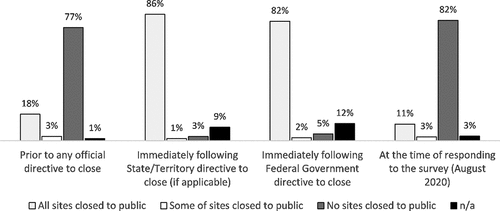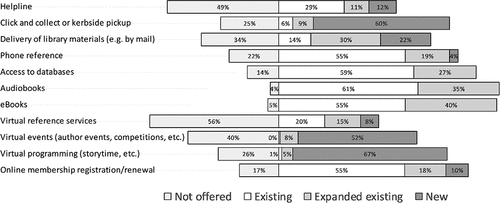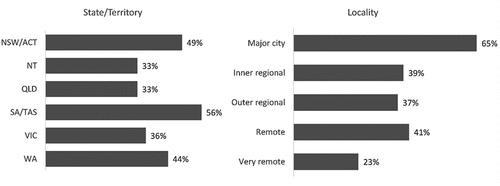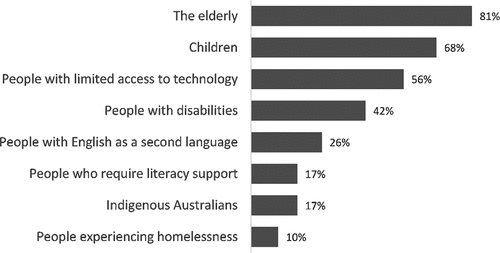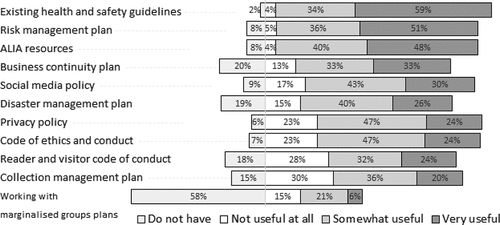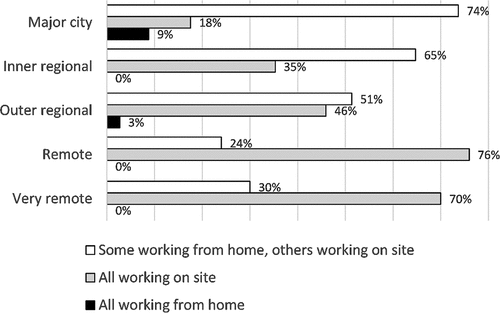ABSTRACT
This paper reports on part one of a multi-part research project investigating Australian public library responses to the requirement to close their physical sites due to the COVID-19 pandemic in 2020. The aim was to examine how Australian public libraries responded to the crisis during their periods of closure in terms of services and resources, the challenges they faced, and the role locality played in their response. In total, 212 public library authority managers completed an online questionnaire survey in August 2020 representing 695 public library branch locations. The results showed that during their periods of closure of their physical sites, libraries established new services (e.g. wellbeing phone calls, delivery of craft kits to users) and expanded several existing ones, especially those related to e-resources. The biggest challenge reported was managing staff working arrangements. While most libraries kept permanent staff and fixed-term staff on full hours, most completely cut volunteers and casual staff hours. There were some geographic differences in the response of libraries to the crisis. Overall, however, whilst metropolitan, regional and remote public libraries faced immense challenges, especially regarding staffing and human resources, they were also able to respond rapidly and with agility to the challenges brought about by COVID-19.
Introduction
The COVID-19 pandemic of 2020 has had impacts on almost all parts of society, at global and local levels. Communities in Australia have been brought together virtually through collective action to stop the spread of the virus, but also kept apart physically through physical distancing guidelines and periods of lockdown throughout the year. Public libraries in Australia have made considerable efforts to respond to these impacts, and this article reports on the first stages of research undertaken during the height of the COVID-19 pandemic in Australia (August 2020) to document and understand these responses.
On 24 March 2020, the Prime Minister of Australia declared the immediate closure of libraries across the country as part of the national attempt to slow the rate of COVID-19 infections (Morrison, Citation2020). This meant over 1,600 public library service points across the country in urban, regional and remote locations, were no longer able to offer services on their premises. Some public libraries shut their doors and ceased to operate. Other public libraries shut their doors to the public, but instead of ceasing to operate, started to evolve their practices to allow them to keep providing services to their communities.
This article reports the overall results of the first of the two phases of a wider study into the response by public libraries across Australia to the COVID-19 crisis. The research aims to assist public libraries in understanding their own roles and performance in a community crisis, and to enable them to better prepare for and react to similar crises in the future so that community needs are met as efficiently and effectively as possible. In addition, the research aims to identify possible trends in future service and resource provision resulting from measures put in place during the COVID-19 crisis. The first stage, which is reported here, involved a national survey of all Australian public library authority managers designed to understand how the libraries for which they were responsible responded to the COVID-19 mandated closures. The second phase of the research will allow for in-depth case studies of three public libraries, one in an urban setting, one in a regional area, and the third in a remote Australian community. These case studies will allow us to explore both the staff and user experience of the COVID-19 closures and to learn how context may influence these experiences. This current article is informed by the first of these phases, and addresses the following two major questions:
How did Australian public libraries respond to the COVID-19 pandemic in terms of services and resources, and what challenges did they face in responding?
What were the similarities and differences in the responses of libraries in different localities?
Literature Review
Both community cohesion and access to accurate information are important ingredients for a successful response to many disasters, and while public libraries are traditionally seen as providers of the latter, in recent times there has been an increasing emphasis on the former, with libraries switching their focus from ‘collections to connections’, that is, to their social and ‘relational’ nature, as community hubs and safe, inclusive spaces (Mathiasson & Jochumsen, Citation2020).
Featherstone et al. (Citation2008) identify eight categories that describe librarians’ roles during and after a crisis: institutional supporters, collection managers, information disseminators, internal planners, community supporters, government partners, educators and trainers and, finally, information community builders. Each category is described in detail. For example, the community supporter role includes several actions such as providing space for community gathering, providing Internet access for evacuees, sending mobile units to shelters, managing donations; organising volunteers, working in shelters, assisting people to find their family members and many other forms of community assistance. It may be that some of these roles are more important in certain types of crisis. Indeed, Featherstone et al.’s (Citation2008) work focusses on disasters that have a physical effect on communities and their environments, such as floods, earthquakes and other forms of natural disasters, and assumes that the library sites can remain open during and/or after the crisis events.
Commentary on public libraries in times of crisis have highlighted the need to consider how they can support their communities not only during the crisis itself, but also in the period of recovery that follows (Garvey, Citation2015). This support is more effective when it is guided by an established plan, covering both crisis and recovery periods (Ilo et al., Citation2018; McGuire, Citation2007; Panovska-Griffiths et al., Citation2019).
The literature also indicates that during a crisis, librarians are frequently among the groups of professionals who volunteer to move beyond their conventional duties and contribute in new ways. For example, Donahue and Featherstone (Citation2013) reported that during some periods of disaster such as the aftermath of Hurrican Katrina, hospital librarians performed activities such as preparing and delivering food to people in need. They called for more research on how librarians could also utilise their professional skills in new ways in the face of disasters. Meanwhile, Veil and Bishop (Citation2014) have identified various opportunities for libraries to boost community resilience through a wide range of activities for adapting or expanding services already offered to meet the new needs of the community in times of crisis. Public libraries have been involved in responding to many instances of disaster and crises, and have often been regarded as key services during and after them. The literature covers public library responses to hurricanes (Peet, Citation2017), floods (Braquet, Citation2010; Tu-Keefner, Citation2016), bushfires (McKerracher, Citation2009), epidemics (Ghosh, Citation2005) and recently pandemics (Cleave & Geijsman, Citation2020; Daly, Citation2020; Kosciejew, Citation2020). Public libraries often provide special services in times of crisis, including establishing emergency shelters during hurricanes (Garvey, Citation2015; Merenda, Citation2015) and delivering health-related information during public health crises (Featherstone et al., Citation2012; Hagar, Citation2009; Harris et al., Citation2005).
The American Library Association (Citation2020) conducted a survey of their public libraries and reported that in response to the COVID-19 outbreak, while most libraries (98%) were closed to some extent they continued, expanded or added to their services, especially their online services (e.g. e-books and streaming media and virtual programming). Moreover, library staff have addressed specific community needs by developing new online resources (e.g. activities to do at home and resources for the unemployed), expanding access to services (e.g. for the deaf/blind/disabled), waiving overdue fines, distributing special materials (e.g. free supplies, kits, bookmobile deliveries), setting up helplines, and providing technology support (e.g. hotspot checkouts and wifi), as well as by providing resources related to the virus itself.
Wang and Lund (Citation2020) carried out a content analysis of a sample of American public library announcements relating to the pandemic. The results indicate 95% of these libraries were temporarily closed in response to the crisis and 98% of their programs were suspended. However, 16% offered virtual programs to replace their normal activities. The majority of them encouraged patrons to use digital resources when possible and over half of them announced that all overdue fines were waived. They also provided links to reliable health resources. Their study found that the contents of many announcements changed over the course of the period, demonstrating the rapidly evolving nature of the crisis. They concluded that libraries can and do play a key role in providing reliable information for their communities during the pandemic.
Tammaro (Citation2020) reports that during the closure of libraries in Italy, access to online resources has increased considerably and librarians have focused on user engagement and communication, and on ensuring that even during the lockdown their library services are available in alternative formats via digital platforms. They have also organised online events with authors, translators and publishers, and online courses on various activities (e.g. gymnastics and cooking). Further, they initiated a number of projects to promote their service offerings to users during the COVID-19 crisis. For example, the CSBNO Consortium (Culture Sociality Libraries Network Operative) has made over 16,000 phone calls to its registered users to promote user awareness and engagement with the online services and resources their libraries have offered. Despite the growing number of studies focused on libraries and COVID-19, this is still an emerging field of research, with many questions needing to be addressed through further research. For example, research is needed on the possibility of virus transmission through library materials (Yuvaraj, Citation2020). Matthews (Citation2020) is among several authors who have raised important questions for librarians to consider when they reopen their libraries. They suggest a need to reflect on practical issues such as how librarians can protect the safety of their staff and patrons; what services should be retained or expanded; how the library’s website should be modified to address new needs; how often they should clean and disinfect computers, tables and other furniture; how can they re-arrange furniture to encourage physical distancing; and what new services they should provide to address the new (and still evolving) needs of their communities.
In summary, the current literature on libraries and COVID-19 is only beginning to emerge. It includes reports on some responses but does not yet paint a full picture of libraries’ contribution to this crisis, in any country, raising as many questions as answers. There is an urgent need for more empirical research to provide a strong foundation for evidence-based practice and policy development.
Methodology
In this article, we report the result of an Australian survey of public libraries that was undertaken during August 2020. The Australian Public Library Alliance (APLA) is the key reference group for the project. APLA, which also advises the Australian Library and Information Association (ALIA), is made up of representatives from state-based library associations and territory libraries. APLA provided the research team with a comprehensive distribution list of all public library authority managers and their email contact details. Ethics approval to undertake the research was obtained from Charles Sturt University before the survey was administered, and the survey was piloted by the APLA reference group. Data were collected between 5 August 2020 and 19 August 2020, when COVID-19 restrictions were still in place in most localities, including a complete lockdown in Victoria.
The survey investigated aspects of public libraries’ responses to the COVID-19 crisis, with a particular focus on their responses to physical closures of library branches and the measures taken to maintain contact and services to their communities. The national survey was developed and delivered via Survey Monkey and included questions that examined the role of each library authority in supporting their communities; how decisions regarding closures of library buildings were made; what new and existing online resources and services were made available to users; how libraries maintained service delivery to vulnerable communities; how prepared the libraries were for such a crisis; what were the greatest challenges libraries faced in managing online-only delivery; how libraries have or will evaluate their responses to the crisis; and the likelihood of ongoing post-crisis changes to service and resource provision. To enable the researchers to distinguish between the responses of libraries in different localities, library managers were asked to identify their state or territory, and the types of locality covered by their library service. The types of locality from which respondents were asked to select follow the Australian Bureau of Statistics Remoteness structure of major city, inner regional, outer regional, remote and very remote (Australian Bureau of Statistics, Citationn.d.). In order to ensure their anonymity, respondents were not asked to provide any other identifying information.
A link to the online survey was distributed by email to the 477 contacts on the distribution list, asking for responses from public library networks covering a total of 1,450 branches throughout Australia. The email contained an explanation of the goals of the survey and a link through to the survey itself. The first screen of the survey provided further information and survey instructions to the recipient, and informed consent was granted by proceeding beyond this first screen. It was asked that respondents complete the survey on behalf of their respective library authority or network. Two-hundred and twelve responses were received, representing 695 public library branch locations, and a 44% response rate. and illustrate the distribution of the responses by state/territory and type of locality.
Table 1. Distribution of responses by state/territory
Table 2. Distribution of responses by type of locality
The survey generated both qualitative and quantitative data that has been analysed for this article and summarised in the following Findings section. The data set is also publicly available to download here: https://figshare.com/articles/dataset/Australian_Public_Library_COVID_Survey/14183060. Since the survey was completed by single individuals for both ACT and Tasmania, to comply with ethics requirements their results have been combined with other states to avoid any single individual’s responses being identifiable. ACT results have been combined with NSW, and Tasmanian results with SA. Although Tasmania is more commonly combined with VIC in such instances, it was felt that the prolonged library closures in Victoria meant their experience of the crisis was potentially quite different to other states, and therefore combining with Tasmania with SA would ensure Victorian data were presented accurately. The data were analysed through a multi-methods approach; descriptive statistics were used to analyse the closed question responses, and responses to the open-ended questions were coded thematically and categorised by the research team. The larger rich qualitative data set will be reported in depth in other publications, but also reported here where it adds or reinforces findings from the quantitative data.
Findings
Library Closures
The first part of the survey related to library closures. We asked managers to describe the status of their library sites at four different points during the crisis: before any external closure directives; immediately following any applicable state or territory directive; immediately following the federal directive; and at the time of responding to the survey (). It is notable that 21% of authorities had closed at least some of their sites prior to any official closure directive. A large majority of respondents (86%) reported that all their sites were closed following either a state-level or federal-level directive, while 82% of respondents reported that all their sites were open at the time of their response (in August 2020). However, eight respondents (five of whom were from Outer Regional localities) indicated that some of their libraries remained open throughout the crisis. Respondents noted that there were sometimes issues with interpreting directives about what part of the service fell under the ‘closure’:
Unfortunately, our state association misinterpreted requirements from the Chief Medical Officer and from the Police Commissioner and advised complete closure – services as well as facilities. Overall [t]he majority of metropolitan libraries closed, and many did not provide curbside services. We closed our facilities to the public but maintained as many services as possible albeit in different formats.
Services and Resources Offered
While most library sites were closed to the public during the crisis, public libraries continued to serve their users. We asked respondents about the online resources and remote services their authorities had been providing over the period. As illustrates, many authorities started offering virtual programs and events and instituted new ‘click and collect’ services. Over 20% also started new home delivery services, while a further 30% expanded existing such services. Most library authorities expanded their existing provision of e-resources (databases, ebooks, online audiobooks, etc.).
As well as the programs and services listed in the survey, participants were able to note other programs or services that had been established during the crisis. These included wellbeing phone calls, activity and craft kits delivered to users, document printing and posting services, book donations from weeded stock to vulnerable community groups such as those living in government housing, and the creation of curated genre-based reading bundles. Respondents also identified a range of online and virtual events that they offered while libraries were closed, including craft, chess, and Lego sessions, and movie clubs and book groups.
Social media was one of the key channels used to promote these new services, reflecting the imperative to respond to user needs rapidly, while existing communication infrastructures did not always provide the ability to do this. Libraries also reported partnerships with other sectors of their governing body around a wider breadth of services, including providing staff to deliver fresh fruit and vegetables and precooked meals to community members. Respondents provided significant detail about the breadth of programs in the survey, and more analysis of these responses will be forthcoming.
It is instructive to review the provision of these services and resources by locality. shows the same list of services and resources as , and the percentage of library authorities in each type of locality that offered each one during the crisis (an aggregation of existing, expanded and new). For almost all services and programs there is a clear trend – services were more likely to be offered by major city and inner regional libraries than by outer regional and remote libraries. This was often because major city and inner regional library authorities were more likely to have services in place already. In the case of online membership registration and renewal, for instance, analysis of the underlying data reveals that the vast majority (98%) of major city libraries already offered this service, whereas just over half of remote and very remote libraries offered this before the crisis. In the case of virtual programming and virtual events, however, this was not the case. These online events were much more likely to be offered by major city libraries than remote or very remote libraries, but analysis of response data shows that in 89% of cases these were new services not previously offered by the major city library authorities. It appears therefore that major city libraries were more able to develop these programs than remote library authorities.
Table 3. Proportion of library authorities offering each program/service during the crisis. By locality
Where there was a lack of existing services across the board, such as in the cases of virtual programming and events, it tended to be the major city and inner regional libraries which were able to be more innovative, adding new services in far larger proportions. In general, major city and inner regional libraries tended to expand and add to their online collections more than remote libraries did, while the latter added more physical delivery services; libraries in all localities added large numbers of ‘click and collect’ services. The inner regional libraries tended to offer services in more similar proportions to those of the metropolitan libraries, but with some shortfall.
Effectiveness of Services and Resources Offered
Participants were asked to rate the effectiveness of these services using a 3-point Likert scale (Not at all effective = 1, Somewhat effective = 2, Very effective = 3). The mean values are presented in , with a breakdown by locality. Overall, all the mean values are greater than 2, indicating that in general the library offerings were considered effective by library managers. The service considered the least effective overall was virtual reference (M = 2.4), which was also rated the least effective in all states/territories and localities, except in the case of very remote areas where the least effective was virtual events (M = 1.8). It is notable that despite virtual programming being rarely offered in Very Remote regions, where it was offered, it was considered very effective (M = 3.0). Many respondents were looking to retain services that had been added or expanded, after the crisis, especially those offering e-resources (well over half in these cases).
Table 4. Effectiveness of programs/services in meeting the needs of users (Not at all effective = 1, Somewhat effective = 2, Very effective = 3). Mean value by locality
Communication with Users
Libraries used a range of channels to communicate service changes to their users. As illustrates, the most widely used medium was Facebook (95%), followed by library websites (82%) and signage (79%). Twitter was the least used medium (13%). This overall pattern was broadly the same across different states/territories and localities. The underlying data indicate a few exceptions including the much higher use of SMS messaging in NT (67% compared with 17% overall), and low use of library websites and email in remote and very remote areas.
Table 5. Proportion of library authorities using each communication method. By locality
Public Health Awareness Activities
Almost half (45%) of library managers reported that their libraries undertook public health awareness/support activities in response to COVID-19. However, there were clear geographic differences here (). Public health awareness and support activities were much more likely to occur in metropolitan areas with 65% of respondents from major cities stating that their libraries were carrying out such activities, as opposed to only 23% of respondents in very remote areas. Among states and territories, SA had the largest percentage (55%) of activity in this area, while the lowest belonged to NT and QLD with 33% each. Responses to open-ended questions asking for more detail suggested that in some cases libraries were prevented from performing these kinds of activities by councils or parent bodies.
Support for Specific User Groups
Participants were also asked whether they had taken specific actions to address the needs of particular user groups during the crisis (see ). Most respondents indicated their libraries had taken particular actions to support elderly users (81%), children (68%) and people with limited access to technology (56%). People experiencing homelessness (10%), people who require literacy support (17%) and Indigenous Australians (17%) saw smaller numbers of libraries taking specific action to support their needs. In general, Victorian libraries targeted vulnerable groups significantly more than libraries at large, perhaps due to their greater vulnerability given the state’s ‘second wave’ of COVID-19 infections. The highest proportion of libraries that took action specifically for Indigenous Australians belonged to those in remote areas and NT (33% each).
Management Resources
Understanding the usefulness of corporate plans, internal or external documents or resources during the crisis could be influential for future planning. illustrates the reported usefulness of a range of plans, documents and resources. Existing health and safety guidelines were considered very useful by the largest number of participants (59%), followed by risk management plans (51%). ALIA resources were considered very useful by almost half (48%) of library managers, while business continuity plans and social media policies were very useful for around a third of respondents. Along with ALIA, state libraries were also named in the free-text responses as valuable sources of advice; other influential bodies named included state and national departments of health, and local government associations. Interestingly, 115 respondents (58%) reported that their authorities did not have plans or policies for working with marginalised groups. Collection management plans, reader and visitor codes of conduct, and privacy policies were generally considered less relevant to the handling of the crisis. Some respondents also noted that their experiences with the recent bushfire emergencies meant their plans were up to date and that consequently they felt well prepared.
Staffing
Library managers were asked about staffing, and the extent to which various categories of library staff remained on full working hours or had those hours partially or fully reduced. shows that a large proportion of library authorities (80%) kept all their permanent staff on full-time hours, with almost as many (71%) maintaining the hours for fixed-term staff. The situation was very different for casual staff, however, with 58% of authorities completely cutting all their casual staff hours. Volunteers in even more authorities (77%) saw their hours cut completely.
Table 6. How would you describe your service’s response to the closure of libraries in terms of staff undertaking library-related duties? (% of library authorities)
While these figures are illuminating, it is also important to consider them alongside the free text responses provided by respondents. The questionnaire asked for more details about staffing issues, and managers provided detailed descriptions of the difficulties they had experienced during the crisis. Many emphasised that trying to support casual staff was among the greatest challenges they faced, and there were a range of strategies used to minimise the impact on these staff. Some authorities were able to provide paid leave for casual staff, based on calculations of typical pay over preceding months, while others described efforts or directives to re-allocate casual library staff to other parts of the organisation:
… staff took up temporary positions created by State Library specifically for public library staff that had been stood down due to COVID.
Despite these efforts, however, it seems clear that casual employees were the most severely affected sector of the public library workforce.
We asked about the location of work for staff that remained working either on full hours or partially reduced hours (). Fifty-five percent of respondents said that some worked from home and others worked on site. Only 4% of managers reported all staff working from home. Library authorities in remote localities were most likely to have had all their staff working on site.
Some library staff were asked to undertake non-library duties for the council or parent body (). The percentage of library authorities that reported some staff carrying out such work was 42% overall, with staff called on to undertake non-library tasks more in metropolitan than in remote areas. It was noted that this created opportunities for librarians to develop networks and relationships within their council, with one respondent noting that ‘staff enjoyed working in other departments of the Shire. It has created stronger links between people and between departments.’
Figure 7. Proportion of library authorities that required some staff to undertake non-library work for the council/parent body
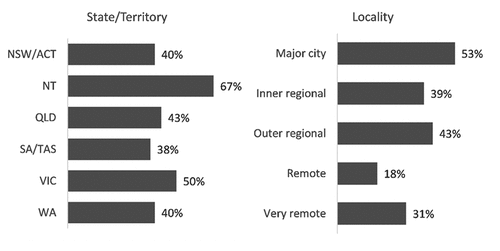
Staffing issues also changed over time, with respondents noting different difficulties in the early stages of transition and towards the end of the lockdown period. At the start of the crisis challenges were associated with moves to remote working (‘we had issues with initially setting up all staff to work from home’), while in later stages there were issues with keeping staff productive (‘towards end of closure period it was getting more difficult to find work for staff to do’), and managing staff returning to the library (‘the most difficult transition was from home back to work for most staff’).
Challenges
Six potential key challenges were listed for respondents to rate from 1 (Not at all challenging) to 5 (very challenging). Results are presented in . The biggest challenge was reported to be managing staff working arrangements (M = 3.1), with technical capacity (2.7), internal communication (2.6), staff skills (2.5) and remote working (2.4) all mid-range, and licencing of e-products regarded as less of a challenge (1.9). The significance of challenges varied by location. In very remote areas, staff skills and internal communication were rated as more significant issues. While remote working was among the bigger challenges in major cities, it appeared to be less challenging in very remote and remote areas, although as noted above, working from home was in any case a much less frequent occurrence in remote areas. Victorian library staff were generally challenged more on all these issues, and particularly that of staffing arrangements, perhaps because of the second wave lockdown unique to this state.
Figure 8. How challenging library authorities found various aspects of managing their response to the crisis (1 = Not at all challenging, 5 = Very challenging). Mean value by state/territory
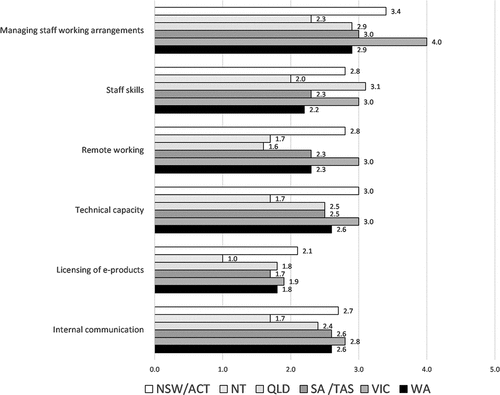
Figure 9. How challenging library authorities found various aspects of managing their response to the crisis (1 = Not at all challenging, 5 = Very challenging). Mean value by locality

Free-text responses indicated that in addition to the factors listed in the survey, managing the wellbeing of staff was a major challenge, with one respondent commenting that ‘managing staff anxieties both about remaining in the workplace and the prospect of being sent home was the most challenging aspect’. This was an experience shared across all states/territories and all localities within those states and territories. For some staff the constant change, unpredictability and uncertainty of what would be required of them as the pandemic developed, and a feeling of not being in control of their own activities, was a source of stress. Requirements to adapt quickly to new technologies and modes of working exacerbated these issues. Many managers also noted that for many of their staff, the return to work on site was the most stressful and anxiety-inducing period.
Parent Bodies
The communication between libraries and their parent bodies (usually councils), and councils’ support for their libraries, during the period of crisis were also explored by the survey. Three statements were given to respondents about this relationship, who were asked to indicate how much they agreed or disagreed with them on a scale of 1 (strongly disagree) to 5 (strongly agree). shows the overall mean value for each statement. There was very little variation in responses from different states/territories, and between different localities. Overall, a majority of respondents either agreed or strongly agreed with all three statements.
Table 7. Respondent perceptions of their council/parent body’s relationship with the library (1 = Strongly disagree, 5 = Strongly agree). Mean value
While these results suggest that in general libraries and parent bodies engaged positively, it is important to note the significant number of exceptions to this. Just over a quarter of respondents (27%) disagreed or strongly disagreed with the statement that their parent body understood the operational needs of the library. Furthermore, 14% of managers disagreed or strongly disagreed with the statement that their parent body has been committed to the delivery of library services. Some of these managers noted in their free-text responses that a less favourable relationship with their council had led to major difficulties, in which ‘the bureaucracy spread faster than the virus’. Indeed, some councils’ lack of knowledge about libraries and how they operate meant that library managers felt unsupported. One respondent commented that ‘Council formed a COVID-19 working party but it did not include any staff who manage delivery of services to the community […] This was challenging as decisions were being made by staff who did not manage the library and the communication was slow.’
In other cases, communication was an issue, with councils leaving staff unsure of what was required of them, and in a few cases feeling ‘abandoned’. In contrast, another relatively common complaint was that councils had over-scrutinised library work and productivity during site closures. As one respondent commented:
All library staff work every day at their normal jobs out of sight of the executive team without having to provide evidence, and could not understand why suddenly they were not trust[ed] to continue to do so, and/or that tasks they had planned to undertake during the closure were not of value to the organisation.
Evaluation
Reviewing and evaluating responses to a crisis is an important way to prepare for future events. Respondents were asked whether they had formally reviewed both their service’s internal response to the crisis by the time of completing the survey (August 2020), and user perceptions of their response. shows that only a small proportion (21%) of authorities had conducted a formal review of their response, with even fewer having evaluated user perceptions of their response (14%). However, about half of the authorities were planning a review in the future. The free-text responses to this question suggest that some libraries have been conducting informal, ongoing reviews through conversations with staff and users. As one respondent put it:
We have been doing agile reviews regularly and incidentally. We have been iterating our service delivery according to these incremental review processes and the outcomes of same.
Figure 10. Proportion of library authorities that have reviewed or plan to review their service’s management of the crisis, and user perceptions of their response
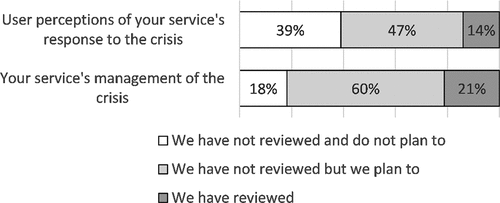
We also asked participants what processes or methods they had used or planned to use to support these evaluations. shows that around two-thirds of libraries have used or plan to use usage data to investigate their response, and user perceptions of that response. Three-quarters of respondents suggested surveys would be used to explore user perceptions of their response to the crisis. Respondents selecting ‘Other’ identified a range of alternative processes in the free text box, including continuous reviews, agile reviews, and informal reviews.
Table 8. Formal processes for evaluating their service’s response to the crisis (% of library authorities)
Discussion
Services and Resources
Research question 1 related to understanding how Australian public libraries responded to the crisis in terms of services and resources. Since the beginning of the COVID-19 global pandemic in early March 2020, public libraries around the world have been involved in a wide range of activities to help their communities to deal with the crisis, as the literature review above has outlined. Our findings show that this is no different in Australia, with a wide range of services and programs being continued, extended or added by Australian libraries over the period.
In particular, our findings demonstrate how Australian public libraries responded to the COVID-19 pandemic in terms of services and resources, and provide an outline of the key challenges they faced. In Featherstone et al.’s (Citation2008) work on the role of libraries in times of crisis, eight roles were identified: institutional supporters, collection managers, information disseminators, internal planners, community supporters, government partners, educators and trainers, and information community builders. It is interesting to note that some of these roles are clearly identifiable in the Australian public library response to the COVID-19 pandemic. In particular, the priority placed on maintaining and expanding access to electronic and online material clearly maps to the collection manager role, while the widespread conversion of library events and programs to online formats, and activities like welfare phone calls, represent libraries playing the role of community supporters. Other roles identified by Featherstone et al. (e.g. government partners, or educators and trainers) do not appear to map to activities undertaken during this crisis, at least not in the ways defined by Featherstone et al. This is perhaps indicative of the unique nature of this crisis, and in particular its prolonged duration, the requirement to close library buildings, and the restrictions it has placed on human contact. Further work might seek to expand and refine existing models of libraries in times of crisis to better encompass the conditions faced during this crisis.
Our study shows that public libraries were able to move many of their services into an online environment despite the short notice many had regarding the closure of their physical sites and the potential resourcing challenges they might have faced, including technical capacity and staffing. One major city library survey response celebrated this outcome with the words:
Libraries were awesome - the steady ship during the crisis. We stood by each other, adapted to help our customers, and got the job done. We should acknowledge and promote the great work library staff have achieved.
Most libraries closed their physical sites at the time of the state and federal directives, with some (18%) closing beforehand. This did not mean less activity, but instead resulted in the expansion of a significant number of services, including the provision of e-resources and innovative outreach activities. New services included ‘click and collect’ or pick-up borrowing, and certain types of virtual programming and events, although it is important to note that metro and inner regional libraries were much more likely to develop new virtual services and programs than remote libraries. Additional research would be required to understand the reasons for this, but it is possible that the capacity of staff, the availability of technical infrastructure, and the perceived needs of users were factors in this discrepancy.
Many libraries provided relevant health information to their communities, but in most cases, this was not deemed by library staff as the most important element of their response. Of most value were the efforts to continue providing the services and resources their patrons were used to, in ways that were ‘COVID-safe’, with an emphasis on supporting ‘social capital’, community well-being and attending to vulnerable groups.
While only a small proportion of libraries have undertaken user evaluations of their services for the period of crisis, from the librarians’ own perspectives the expansion of existing resources was particularly effective. Highlights included home and kerbside delivery, the enhancement of their online collections (including audio, as well as e-books) and virtual programming. The latter was viewed as particularly effective for very remote public libraries. Many libraries are planning further research to investigate their users’ perceptions of these services.
Libraries were able to achieve ‘quick wins’ with some forms of expansion being relatively straightforward to achieve. E-licencing was one of the least challenging components of managing services, for example, as many changes to offerings are facilitated at a state or national level rather than having to be negotiated separately by staff at each library site. ‘Technical capacity’, in contrast, was rated as more problematic, which could well have curtailed the translation of certain physical services to an online mode. Where new services have been supported through a shift of resources, including human resources, from physical services, it remains to be seen whether they can continue once resources are needed again to support the resumed physical services.
Challenges
Research question 1 also explored the challenges faced by public libraries during the crisis period. The literature indicates that during a crisis, librarians are frequently among the groups of professionals who volunteer to move beyond their conventional duties and contribute in new ways (Donahue & Featherstone, Citation2013). In our study, a significant involvement in other council work was also reported, including public health messaging, and community outreach more broadly than that exercised specifically for library services.
Managing staff was seen as a significant challenge, as was ensuring staff had appropriate technology, as well as the technical skills, to undertake working from home. A significant proportion of casual staff (and volunteers) saw their hours reduced to zero, or were laid off entirely during the library closures. Many managers emphasised that trying to support casual staff was among the greatest challenges they faced and cited a range of strategies used to minimise the impact on these staff. Some authorities were able to provide paid leave for casual staff, based on calculations of typical pay over preceding months, while others described efforts to re-allocate casual library staff to other parts of the business. Despite these efforts, however, it seems clear that casual employees were the most severely affected sector of the public library workforce.
Other challenges experienced by libraries related to technical capacity, including often poor access to reliable internet and devices, and insufficient staff skills required to undertake project work in isolation from colleagues. Technical challenges were more frequently observed in libraries in remote localities, but this was somewhat offset by the reduced requirement of staff from these libraries needing to work from home. Internal communication, was a moderate challenge for libraries across all localities.
Locality
Research question 2 explored whether there were geographical differences in public library responses to the crisis. The survey investigated the impact of locality on public libraries’ responses to the COVID-19 pandemic and found in many cases that there was a relationship between the location of a library and the type and variety of services and resources provided during the crisis period, with a wider range of services more likely to be offered in major cities and inner regional areas. These localities may have more demand for such a range, due to their larger populations, and may have be in a better position to benefit from online offerings due to a higher level of internet access. However, it is by no means only metropolitan Australia that has relied on online services and communication during the COVID-19 crisis, and this finding may require a review of public library resourcing to ensure regional equity when disasters of this nature occur in the future. Regardless of their location, the varied relationships libraries had with councils during the crisis, some positive, some negative, reinforce the importance of building good, ongoing relationships with parent bodies.
Conclusion
This article has reported on the first of a multistage research project into the impact of COVID-19 on public libraries in Australia. The research has demonstrated that whilst metropolitan, regional and remote public libraries in Australia faced immense challenges while their library sites were closed, especially regarding staffing and technology, they were also able to be the ‘steady ship during the crisis’, and to respond rapidly and with agility to the COVID-19 closures. Public libraries reported innovations in service provision and community outreach, and stressed the importance of strong relationships with parent bodies and clear guidance from relevant documents and policies. Their ability to work with agility and innovation to meet the evolving needs of their users during a crisis such as the COVID-19 library closures was a positive and impressive response from our public libraries. However, these efforts were often made more challenging by restrictive relationships with parent bodies, complex and sometimes contradictory information flows, insufficient IT infrastructure and connectivity and the understandable fragility of staff members faced with a unique and frightening situation. Phase two of our study will reveal the extent to which these challenges affected the experiences of users of one urban, one regional, and one remote public library, selected from across Australia, as well as explore more deeply the ways in which the challenges were met by the librarians on the ground (or not on the ground). Together, the two phases of this research will not only contribute to the broad question of the role of public libraries in the lives of their communities during crises such as the COVID-19 pandemic, but will also pave the way for future research around the evolution of public library services, and the community’s relationship with these services, in a post-COVID world.
Acknowledgments
We would like to thank all of the public libraries that responded to the survey. We would also like to thank ALIA and APLA for the support that made it possible to conduct this study.
Disclosure Statement
No potential conflict of interest was reported by the authors.
Additional information
Funding
Notes on contributors
Jane Garner
Jane Garner is a lecturer at the School of Information Studies at Charles Sturt University. She publishes on topics relating to library services to disadvantaged groups, most specifically adult and child prisoner communities.
Philip Hider
Philip Hider is Professor of Library and Information Management at Charles Sturt University, as well as Associate Dean Research in its Faculty of Arts and Education. He has published extensively in the field of LIS, particularly in the subfield of information organisation.
Hamid R. Jamali
Hamid R. Jamali is an associate professor at the School of Information Studies at Charles Sturt University, Australia. He received his PhD in Information Science from University College London in 2008. His current research interests include scholarly communication, open science and research evaluation.
Jessie Lymn
Jessie Lymn is a lecturer in the School of Information Studies at Charles Sturt University. Her current research focuses on non-normative material in collections, arguing for a consideration of non-linearity, disruption, and productive effects, which includes do-it-yourself (DIY) publications in institutional and non-institutional collections. She also publishes in the area of library and archives studies education.
Yazdan Mansourian
Yazdan Mansourian is a lecturer in the School of Information Studies at Charles Sturt University (CSU). He received his PhD in Information Science from the University of Sheffield in 2006. Between 2007 and 2017, he was a faculty member at Kharazmi University. His current research interest is information behaviour in serious leisure.
Holly Randell-Moon
Holly Randell-Moon is a lecturer in the School of Indigenous Australian Studies at Charles Sturt University. She has published in the areas of critical race and whiteness studies, communication, education, and the knowledge economy. She is interested in culturally responsive approaches to representing Indigenous Australian communities in library systems and diverse understandings of information literacy and digital citizenship.
Simon Wakeling
Simon Wakeling is a lecturer in the School of Information Studies at Charles Sturt University. His research interests include scholarly communication, particularly the open access publication and dissemination of research outputs, and the role and function of public libraries.
References
- American Library Association. (2020, June 3). Public libraries respond to COVID-19: Survey of response & activities. http://www.ala.org/pla/issues/covid-19/march2020survey
- Australian Bureau of Statistics. (n.d.). The Australian statistical geography standard (ASGS) remoteness structure. https://www.abs.gov.au/websitedbs/D3310114.nsf/home/remoteness+structure
- Braquet, D. M. (2010). Library experiences of hurricane Katrina and New Orleans flood survivors. LIBRES: Library and Information Science Research Electronic Journal, 20(1), 1–23. https://www.libres-ejournal.info/528/
- Cleave, J., & Geijsman, J. (2020). LibraryCraft – How the COVID-19 pandemic led to the growth of the WA libraries public Minecraft server. Digital Library Perspectives, 36(4), 377–388. https://doi.org/10.1108/DLP-05-2020-0027
- Daly, D. (2020). The heart of the matter: Academic and public libraries adapt to pandemics through time and technology. Public Services Quarterly, 16(3), 200–205. https://doi.org/10.1080/15228959.2020.1778600
- Donahue, A. E., & Featherstone, R. M. (2013). New roles for hospital librarians: A benchmarking survey of disaster management activities. Journal of the Medical Library Association: JMLA, 101(4), 315–318. https://doi.org/10.3163/1536-5050.101.4.014
- Featherstone, R. M., Boldt, R. G., Torabi, N., & Konrad, S. (2012). Provision of pandemic disease information by health sciences librarians: A multisite comparative case series. Journal of the Medical Library Association, 100(2), 104–112. https://doi.org/10.3163/1536-5050.100.2.008
- Featherstone, R. M., Lyon, B. J., & Ruffin, A. B. (2008). Library roles in disaster response: An oral history project by the national library of medicine. Journal of the Medical Library Association: JMLA, 96(4), 343–350. https://doi.org/10.3163/1536-5050.96.4.009
- Garvey, M. (2015). Serving a public library community after a natural disaster: Recovering from “Hurricane Sandy”. Journal of the Leadership & Management Section, 11(2), 22–31. https://www.nyla.org/max/userfiles/LAMS/JLAMS_14_15V11N2comp.pdf
- Ghosh, M. (2005, August). Save the society from an AIDS epidemic: Indian public libraries in the current perspective [Paper presentation]. World Library and Information Congress: 71th IFLA General Conference and Council, Oslo, Norway. https://archive.ifla.org/IV/ifla71/papers/186e-Ghosh.pdf
- Hagar, C. (2009). Information in isolation: Gossip and rumor during the UK 2001 foot and mouth crisis – Lessons learned. Libri, 59(4), 228–237. https://doi.org/10.1515/libr.2009.020
- Harris, R., Wathen, C. N., & Chan, D. (2005). Public library responses to a consumer health inquiry in a public health crisis. Reference & User Services Quarterly, 45(2), 147–154. www.jstor.org/stable/20864480
- Ilo, P. I., Izuagbe, R., Mole, A. J. C., & Ekwuemec, L. (2018). Measuring disaster preparedness and response practices in university libraries in Nigeria: The role of disaster equipment. International Journal of Disaster Risk Reduction, 31, 85–91. https://doi.org/10.1016/j.ijdrr.2018.04.007
- Kosciejew, M. (2020). The coronavirus pandemic, libraries and information: A thematic analysis of initial international responses to COVID-19. Global Knowledge, Memory and Communication. (In press). https://doi.org/10.1108/GKMC-04-2020-0041
- Mathiasson, M. H., & Jochumsen, H. (2020). Between collections and connections: Analyzing public library programs in terms of format, content, and role and function. The Library Quarterly, 90(3), 364–379. https://doi.org/10.1086/708963
- Matthews, J. R. (2020). COVID-19 and public libraries: A real paradigm shift. Public Library Quarterly, 39(5), 389–390. https://doi.org/10.1080/01616846.2020.1796431
- McGuire, L. (2007). Planning for a pandemic influenza outbreak: Roles for librarian liaisons in emergency delivery of educational programs. Medical Reference Services Quarterly, 26(4), 1–13. https://doi.org/10.1300/J115v26n04_01
- McKerracher, S. (2009). ALIA leads collaborative effort to help bushfire communities rebuild with books. Incite, 30(11), 8. http://www5.austlii.edu.au/au/journals/inCiteALIA/2009/320.pdf
- Merenda, C. A. (2015). How the Westbury library helped the community after Hurricane Sandy. Journal of the Leadership & Management Section, 11(2), 32–34. https://www.nyla.org/max/userfiles/LAMS/JLAMS_14_15V11N2comp.pdf
- Morrison, S. (2020, March 24). Update on coronavirus measures: Media statement. Commonwealth of Australia. https://www.pm.gov.au/media/update-coronavirus-measures-24-March-2020
- Panovska-Griffiths, J., Grieco, L., Van Leeuwen, E., Baguelin, M., Pebody, R., & Utley, M. (2019). Are we prepared for the next influenza pandemic? Lessons from modelling different preparedness policies against four pandemic scenarios. Journal of Theoretical Biology, 481, 223–232. https://doi.org/10.1016/j.jtbi.2019.05.003
- Peet, L. (2017). Libraries from Puerto Rico to Florida respond to Hurricane Irma. Library Journal, 142(17), 12–14. https://www.libraryjournal.com/?detailStory=libraries-puerto-rico-florida-respond-hurricane-irma
- Tammaro, A. M. (2020). COVID 19 and libraries in Italy. International Information & Library Review, 52(3), 216–220. https://doi.org/10.1080/10572317.2020.1785172
- Tu-Keefner, F. (2016, December). The value of public libraries during a major flooding: How digital resources can enhance health and disaster preparedness in local communities. In A. Maeda & A. Morishima (Eds.), Proceedings of the 18th International Conference in Asia-Pacific Digital Libraries (pp. 10–15). Springer International Publishing. https://scholarcommons.sc.edu/libsci_facpub/155/
- Veil, S. R., & Bishop, B. W. (2014). Opportunities and challenges for public libraries to enhance community resilience. Risk Analysis, 34(4), 721–734. https://doi.org/10.1111/risa.12130
- Wang, T., & Lund, B. (2020). Announcement information provided by United States’ public libraries during the 2020 COVID-19 pandemic. Public Library Quarterly, 39(4), 283–294. https://doi.org/10.1080/01616846.2020.1764325
- Yuvaraj, M. (2020). Global responses of health science librarians to the COVID‐19 (Coronavirus) pandemic: A desktop analysis. Health Information and Libraries Journal, 37(4), 337–342. https://doi.org/10.1111/hir.12321

